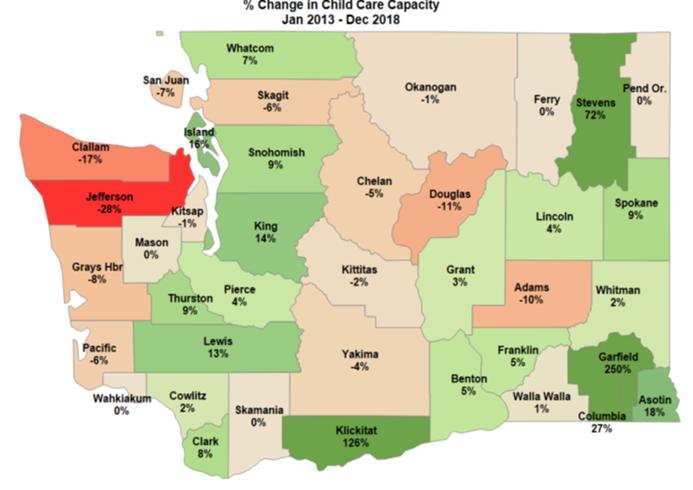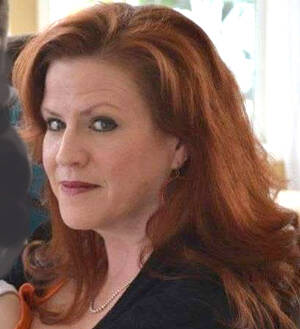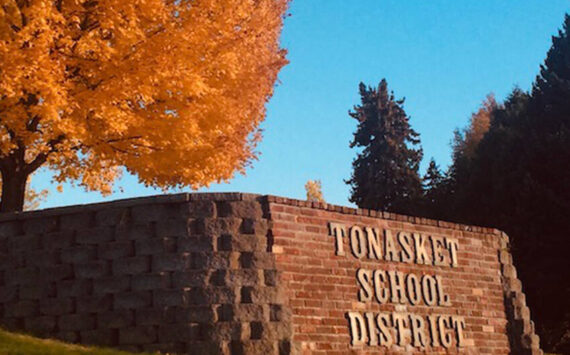Washington parents struggle to juggle work, child care, family finances
Submitted by Marcia Jacobs
Child Care Aware
TACOMA – Parents of young children across Washington struggle to find and afford high-quality, licensed child care. Some areas of the state have experienced significant reductions in licensed child care capacity, while other areas grapple with child care costs that consume large portions of the median income. All areas contend with child care costs that often exceed the cost of college tuition and a state subsidy system that reimburses providers at rates that don’t cover the costs of providing high-quality care, leaving many low-income parents with few, if any, options.
Of Washington’s 39 counties, Whitman, Okanogan and Whatcom counties have the most expensive child care for an infant and a preschooler in a child care center, relative to median household incomes.1 This means that in those three counties the cost of child care for an infant and a preschooler in a child care center consumes between 39.5 – 51.9 percent of median incomes. The average cost of child care statewide for an infant and a preschooler in a center consumes 34 percent of the state median income.
Whatcom, Okanogan and Skagit counties have the most expensive child care for an infant and a preschooler in a licensed family child care home (FCC), relative to median household incomes. In those counties caring for both children consumes between 34.4 – 36.8 percent of median household incomes. Statewide the average cost of care for both children in a FCC program consumes 27 percent of the median income.
“At Child Care Aware of Washington we are working every day across the state to both increase access to child care and to help providers improve the quality of their care,” said Elizabeth Swanson, Interim Executive Director at Child Care Aware of Washington. “Clearly more investment is needed at the state and federal levels, and from the business community, all of whom directly benefit from the child care system every day when working parents show up for work on time and ready to be productive.”
The most affordable counties for child care in a center for an infant and a preschooler as a percentage of median household income are Kitsap, Mason and Island counties, where the cost of care for both children consumes between 30 – 30.7 percent of median incomes. For FCC programs, the least expensive counties are Clark, Kitsap and Thurston counties, where the costs of caring for both children consume between 23.6 and 25.3 percent of median household incomes.
Overall, the cost of child care compared to family income has risen during the past six years. Since 2011, median household income has increased 18 percent, while median child care rates have increased between 19-22 percent for center-based care and 14-22 percent for family child care.2
Several areas of the state have experienced declines in child care capacity, particularly in central WA and the Olympic Peninsula region. Jefferson County has seen a 28 percent decrease in capacity over the last six years, while Clallam County saw a 17 percent decrease. However, some counties are seeing recent increases in child care capacity, including King and Lewis Counties.
Despite the recent increase in capacity in some counties, there has been a general loss of family child care programs overall. This has reduced capacity for child care outside of normal weekday hours – care that is critical to several career fields including healthcare, public safety, travel, retail and hospitality. The percentage of overall capacity for evening, weekend and overnight care decreased from 13 percent in 2012 to only 10 percent in 2018.2
Meanwhile the reimbursement rates paid by the state to providers who accept children whose families use Working Connections Child Care subsidies have not kept pace. Despite recent investments provided by the government, the cost to provide quality child care continues to exceed the reimbursements providers receive for providing care for our most vulnerable children and families. For this reason, many providers accept only a few children at a time on subsidy, or none at all. This further restricts access to high-quality child care for low-income families. The legislature did increase these reimbursement rates for providers in the budget that passed April 28th, but not enough to fully cover the cost of quality care.
Washington ranks on the top 10 list of states with least affordable child care for almost all types of child care for all children ages 0-5, and for the cost of caring for a school-age child during the summer.3
A ReadyNation report released in January calculates the cost of America’s child care crisis is $57 billion annually in lost revenue, earnings and productivity.4 U.S. businesses lose approximately $4.4 billion each year due to employees missing work because of insufficient reliable child care.3 With the unemployment rate at a historical low, employers are increasingly operating with fewer employees than they need. Increased access to high-quality, affordable child care would allow more parents to enter and remain in the workforce.
Solving Washington’s child care crisis requires increased public, business and philanthropic investment in child care and early learning programs. Child Care Aware of Washington advocates for increased investment, both public and private, and for increased access to high-quality care. We work with providers to improve child care quality and help providers save time and money on the business side of their programs with our online shared business services portal Washington Child Care Business Edge.
Child Care Aware of Washington tracks child care supply, demand and costs statewide and in every county. Our data reports are available here: https://childcareawarewa.org/
Child Care Aware of Washington is a non-profit, 501 (c) (3) organization dedicated to connecting families to local, high-quality, licensed child care and early learning programs, and to supporting providers who deliver high-quality care. As a statewide network of six regional agencies, we work side-by-side with child care providers, offering professional development services and higher education scholarships to help providers integrate research-based, best practices into their programs. We are committed to ensuring that each and every child in Washington, regardless of race, religion, gender, ethnicity, culture, primary language or economic status, has access to the quality care and early learning they need to succeed in school and life. For more information, please visit our website at http://wa.childcareaware.org and follow us on Facebook at https://www.facebook.com/






